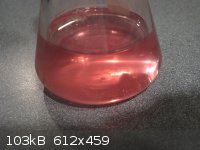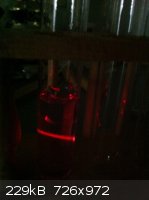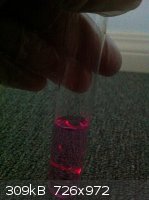Boron Trioxide
Harmless

Posts: 42
Registered: 18-6-2012
Member Is Offline
Mood: No Mood
|
|
Soluble Pink Iron Solution
Well I have recently come up against a mystery substance that I have encountered before.
The first time I made it was when trying to make chlorates through boiling a hypochlorite solution, however at the time I didn't have good glassware,
so I used a frying pan, everything proceeded as expected though near the end the solution changed from a clear-ish yellow to a vibrant pink I might
add this was a Teflon coated steel pan, however the Teflon was severely worn from previous experiments. This solution puzzled and frustrated me though
I didn't think to ask what it was.
Now presently I accidently produced what I believe to be the same solution, however this was produced in a sodium chlorate cell while testing a
experimental magnetite anode. The coating was too thin in spots and wore down, as soon as iron was exposed the anode had no protection, however I
noticed only quite a while later. After stopping the cell, there was a large amount of Fe2O3 at the bottom of the cell as would be expected, however
the solution had once again changed into a similar vibrant pink.
I also should mention that the cathode in this cell was a copper coil, though it was not very eroded by the time the cell was stopped. Also that the
cell had not run for an extended period of time so very few if any chlorates probably formed.
I have attached a picture of a small sample of it, in larger amounts the solution has a darker color.
Any ideas of what this solution is would be appreciated.
Thanks

|
|
|
cyanureeves
National Hazard
   
Posts: 737
Registered: 29-8-2010
Location: Mars
Member Is Offline
Mood: No Mood
|
|
sure would be nice if you could get it to crystallize.
|
|
|
Xenoid
National Hazard
   
Posts: 775
Registered: 14-6-2007
Location: Springs Junction, New Zealand
Member Is Offline
Mood: Comfortably Numb
|
|
Looks like a dilute solution of colloidal ferric hydroxide, to me, it's a darker red when more concentrated.
I used to get this a lot of this in some of my early chlorate cells from corrosion of "stainless" steel in the headspace area, etc.
It is quite difficult to remove, although aluminium sulphate (pool floc) will get rid of most of it by causing it to aggregate into larger clumps
which will precipitate or can be filtered.
|
|
|
woelen
Super Administrator
        
Posts: 7976
Registered: 20-8-2005
Location: Netherlands
Member Is Offline
Mood: interested
|
|
This must be ferrate ion at very low concentration. Ferrate ion has a deep red/purple color and very dilute solutions are pink.
Ferrate ion contains iron in oxidation state +6, the ion is FeO4(2-). This ion only is stable in weakly alkaline to strongly alkaline solutions. In
neutral solutions it slowly decomposes, giving hydroxide, oxygen and hydrous Fe2O3. In acidic solutions it decomposes at once to ferric ion and
oxygen.
I myself made ferrate in somewhat higher concentration by boiling a fresh precipitate of Fe2O3 with 5% bleach. If you do that you get a nice purplish
red solution.
|
|
|
12AX7
Post Harlot
    
Posts: 4803
Registered: 8-3-2005
Location: oscillating
Member Is Offline
Mood: informative
|
|
I've seen this before -- filtering fresh chlorate cell liquor which had some iron contamination (I believe from a rusted iron cathode). After
filtering, I chilled it in the freezer to precipitate what KClO3 would drop; when I retrieved it, I discovered a thin but distinct pink color. I
doubt there was enough to isolate, but if you're curious, barium ferrate has low solubility IIRC. After boiling the solution, the color (and the
hypochlorite smell) went away, and I filtered again, finding some brown gunk.
Tim
|
|
|
Boron Trioxide
Harmless

Posts: 42
Registered: 18-6-2012
Member Is Offline
Mood: No Mood
|
|
I will try to crystallize this though the concentration is very low and contaminated with sodium chloride from the chlorate cell, thanks for your
responses I would not have been able to figure what it was. 
|
|
|
Metacelsus
International Hazard
    
Posts: 2531
Registered: 26-12-2012
Location: Boston, MA
Member Is Offline
Mood: Double, double, toil and trouble
|
|
I got the same pink solution a few months ago in a chlorate cell with an iron cathode and graphite anode. I was able to concentrate it via evaporation
and precipitate it with barium nitrate, so I believe it was ferrate.
|
|
|
amazingchemistry
Hazard to Others
  
Posts: 104
Registered: 4-4-2013
Member Is Offline
Mood: Excited
|
|
Can you try and shine a flashlight through it? If it is a colloid, like Xenoid says, I'm thinking you should get some sort of light scattering due to
the Tyndall effect. If it's a true solution, you'll get no light scattering.
|
|
|
Boron Trioxide
Harmless

Posts: 42
Registered: 18-6-2012
Member Is Offline
Mood: No Mood
|
|
Ok i have tried shining a laser pointer through the solution and there is some light scattering though to me it looks more like Rayleigh scattering to
me though I could be wrong. I managed to get some pictures of it though I had to photograph in almost complete darkness, if anyone has advice for
better photography of this please share.
The scattering proves one of two things in my opinion, either Xenoid is right and it is a colloid or some small particles of the Fe2O3 have
contaminated it, I have done my best to prevent this though the particles of rust were so small i could not filter, I was instead forced to decant the
solution.
[Edited on 18-5-2013 by Boron Trioxide]
 
|
|
|
amazingchemistry
Hazard to Others
  
Posts: 104
Registered: 4-4-2013
Member Is Offline
Mood: Excited
|
|
Besides Aluminum sulfate, would saturated sodium chloride solution work (at least a bit) at coagulating the colloid?
|
|
|
Xenoid
National Hazard
   
Posts: 775
Registered: 14-6-2007
Location: Springs Junction, New Zealand
Member Is Offline
Mood: Comfortably Numb
|
|
Hi Boron,
It's several years since since I had any chlorate cells with the dark red solution, but I remember scratching my head about the stuff and wondering
how to remove it. At the time, the description in "Mellor" for colloidal solution of Fe(OH)3 - "dark red liquid", seemed to fit quite nicely, the
description of K2FeO4 solution as "purple colour" - less so. I must admit, I never bothered to shine a laser through it, but I did use Al2(SO4)3 to
try and floc it, which was reasonably successful and allowed the diatomaceous earth filter to remove most of it.
Re-reading the Mellor section on ferrates and how they are formed does appear to make it likely, as Woelen suggests, that ferrates may form in a
chlorate cell environment. The solution you have appears to be decidedly purplish, I don't remember mine looking like that, they were more of a dark
blood red colour.
Perhaps both species can appear under slightly differing conditions, as I guess each can form from the other - 
|
|
|